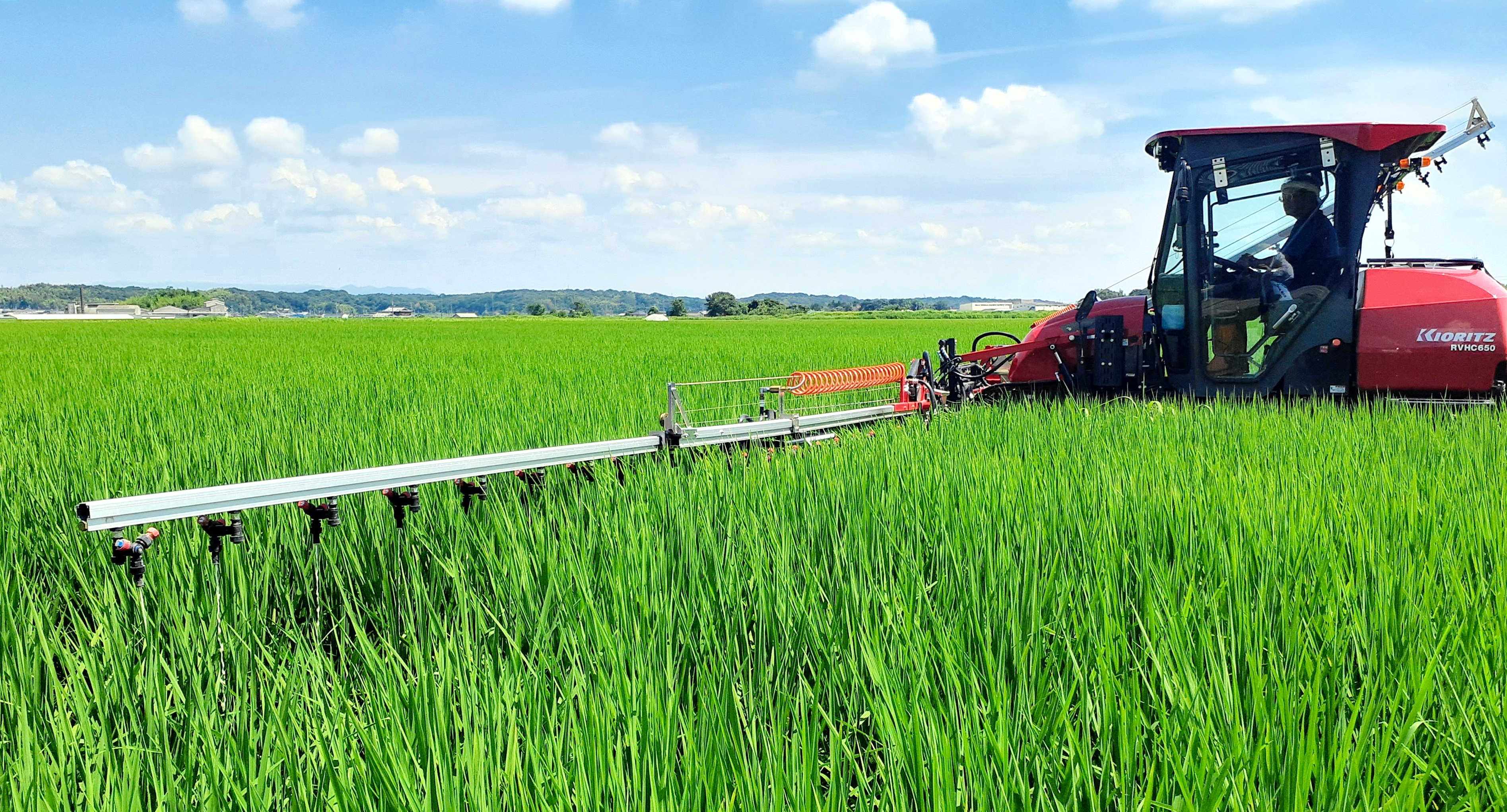Stork Natural Rice Japan’s No. 1 Organic, Pesticide-Free Rice Fields
The chirps of stork chicks calling for their parents echo through the village in the darkness of the evening from a nest tower in “roppo rice field” in Toyooka City. A resident keeping watch as they prepare to make their journey said, "This is the first time the current pair’s chicks will be leaving their nest. It will happen in a few days.” In Tajima, about 30 birds left the nest this year. The cultivation of "stork natural rice," which began in 2003 with 0.7 hectares of rice fields, has now expanded to 600 hectares and is said to be the largest organic, pesticide-free rice production area in Japan. In this article, we bring you the story of "stork natural rice.”
Birds that were once extinct in the wild are now being reintroduced in human-inhabited farming villages. The "Wild Reintroduction Plan," an unprecedented project in the world, was launched in 2003. The project aims to restore the natural environment in its entirety, including rivers, farmlands, and woodlands, so that the storks, which are carnivorous and consume copious amounts of food, can survive. The key to success was a shift away from rice farming that relied on pesticides and chemical fertilizers, which had contributed to their extinction in the first place. The farmers increased the number of rice field organisms such as frogs, spiders, and dragonflies that eat pests, and now suppress weeds without using herbicides. The table in “Saibai Koyomi” (Cultivation Calendar), which contains a 20-year history of the establishment of this farming method, is filled with details of a full year’s work for farmers.
“Winter-Flooded Rice Fields”

Toyokura Farmers' Association spraying digestive solution in winter-flooded rice fields, Kasai City
The basic method of "winter-flooded rice fields" is also known as "winter-flooding”. In rice cultivation, water is usually flooded in the spring when rice is planted, but in the “stork-friendly farming method”, the drainage openings of the rice fields are closed to store water from around November. The rice straw and other materials then decompose, and a “creamy layer" is created in the rice fields through tubifex worms and other organisms. This layer is several centimeters thick, rich in microorganisms, and prevents the germination of rice field weeds, playing a major role in supplying nutrients to the rice. Ichio Narita, chairman of the Advisory Group on Stork Friendly Farming Methods, explains the importance of tubifex worms. “It is said that 3,000 of them per square meter can suppress weeds and 10,000 can eliminate the need for fertilizers.”
Another technique used to control weeds is spraying rice bran after rice planting. In addition, out of consideration for living creatures, farmers established a rule to delay the "mid-drying" process, in which the rice fields are dried once in order to revitalize the roots of the plants. Delaying this allows the tadpoles that grow in the rice fields to turn into frogs and dragonfly larvae to mature into adults.
Along with production expansion, professional farmers and agricultural cooperatives have also been developing their branding and sales channels. JA Tajima sells a total of 1,240 tons of JAS (Japanese Agricultural Standards)-certified organic, pesticide-free, and pesticide-reduced products to supermarkets and co-op stores in the Tokyo metropolitan area, the Kansai region, Okinawa, and overseas.
However, in recent years, due to the aging population and other factors, the number of rice producers and the area available has become limited, and they can no longer meet the market demand for pesticide-free rice. On the other hand, storks have been flying from Hokkaido to Okinawa and South Korea, surprising many and playing a "leading role" in promoting environmental restoration and a shift to ecologically friendly rice cultivation in various regions.
Reservoirs, Paradise for Young Birds
The number of wild storks has exceeded 300 this year, and their breeding grounds have spread to nine prefectures, including Kyoto, Shimane, and Tochigi. The Kakogawa River basin, where the young birds are visiting in large numbers, has been the focus of attention. With 22,000 reservoirs in Hyogo, the largest number in Japan, you can find many large reservoirs in the Higashi-Harima and Kita-Harima areas in particular. When they are drained in winter, storks gather there to feed on fish and other food. Kazuaki Inaba, director of the Toyooka Municipal Museum of the Oriental White Stork, laughs, "Single young birds are coming to visit after inviting their friends outside the prefecture.” The reservoirs are a paradise for young birds in winter but are nowhere to be seen after spring when the water is increased. At the same time, those fascinated by the storks have begun to make various attempts to further encourage them to settle into the area.
SDG-Based Japanese Sake

JA Tajima's "Stork Natural Rice" cultivated by utilizing the power of the ecosystem, Toyooka City
The Toyokura Farmers' Association in Kasai City has been working in "local SDGs sake production" that recycles local resources since 2020. Based on winter-flooded rice fields, they cultivate Yamada-Nishiki sake rice without using insecticides or herbicides. Although originally thought to be difficult to produce, they have shown that winter-flooded rice fields are possible in Harima, where rainfall is scarce.
Yoshinori Tanaka, the head of the association, and his team also appreciate winter-flooded rice fields from the standpoint of energy consumption. Thanks to the creation of that “creamy layer”, they can eliminate the need for repeated plowing with a tractor, which was previously the status quo for rice cultivation. In addition, no fertilizers are used, except for the "digestive juice" obtained from the fermentation of food and agricultural wastes, which is used to energize the microorganisms. The second-year sake "Meguru" will go on sale in mid-September and is said to "reduce the use of energy for rice cultivation by 40% and reduce the burden on the global environment.”
From a Frog’s Perspective Once More
While Harima, Awaji, Fukui, and Tokushima are all abuzz with the arrival and breeding of storks, Akira Murakami, who grows stork natural rice in Asago City, has gone back to the basics of "nurturing the ecosystem" to promote a new initiative. Murakami has been reconsidering how his winter-flooded rice fields impact Tonosama frogs, which he feels have been decreasing in number in recent years. He believed that by filling the fields with water, which makes them like ponds, the frogs have no place to hibernate, so he has decided to only store rainwater. In addition, he has started to leave rows of black soybean fields to be cultivated next to the rice crop for hibernation. He felt like it had a positive effect when he saw many frogs emerging from the large rows he plowed in the spring. “Rice field weeds are no longer growing after three years of field cultivation. So, I want to focus on using black soybeans for weed control, too."
As the birds come back to life in the sky and create a new “terroir”, the story of "agriculture" pieced together by people who have decided to live with them will continue.
Written by Kazuyoshi Tsujimoto, Manager of Corporate Planning Department, Senior Staff Writer at The Kobe Shimbun (Daily Newspaper)
This article was first published on 28th August 2022 in The Kobe Shimbun as part of a series entitled "Wind, Water and Earth...Hyogo's Terroir"
Date : 2024.05.29



